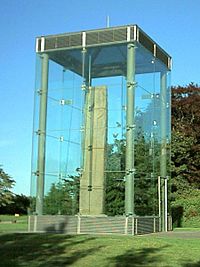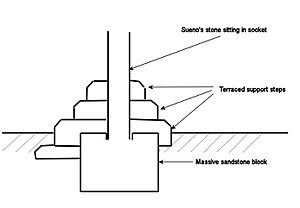Sueno's Stone facts for kids
Quick facts for kids Sueno's Stone |
|
|---|---|

Sueno's Stone in Forres
|
|
| Material | Old Yellow Sandstone |
| Size | 6.5 metres (21 ft) |
| Symbols |
|
| Created | c. 850–950 |
| Present location | Forres, Moray |
| Classification | Class III |
| Culture | Picto-Scottish |
Sueno's Stone is a very old and tall stone monument. It was made by the Picts, an ancient people who lived in Scotland. You can find it in Forres, a town in Moray, Scotland. It is the biggest stone of its kind still standing in Scotland, reaching about 6.5 metres (21 feet) in height! It stands on a small hill next to an old road.
The stone is named after a Viking king called Sweyn Forkbeard. However, some people think it might be linked to the death of King Dubh mac Ailpin in Forres in the year 966. The stone was put up around 850 to 950 AD. No one knows for sure who put it there or why.
What Sueno's Stone Looks Like
Sueno's Stone is a tall stone slab with a cross carved on it. It has amazing patterns of knots woven together on its sides. The stone is made from local yellow sandstone. This type of stone is common in the area. Over time, some parts of the stone have worn away due to weather.
The west side of the stone has a beautiful Celtic cross. It is decorated with fancy woven patterns. Below the cross, there is a picture that is hard to see clearly. It might show a king being crowned.
The east side of the stone tells a story in four parts. It shows a big battle scene!
- The top part is quite worn. It shows rows of people riding horses.
- The second part shows soldiers fighting on foot.
- The third part is a bit gruesome. It shows soldiers who have lost their heads. Their heads are piled up. Other soldiers, archers, and horsemen are around what might be an old fort called a broch.
- The bottom part shows the winning army leaving the battlefield.
The sides of the stone also have detailed carvings. In the early 1990s, the stone was put inside a strong glass case. This was done to protect it from further damage from the weather.
Legends About the Stone
There are some interesting stories about Sueno's Stone.
One local legend says that this was the place where Macbeth first met the three witches. This story comes from Shakespeare's famous play. The legend also says the witches were trapped inside the stone. If the stone ever broke, they would be set free!
Another story suggests the stone was put up for King Dubh mac Ailpin. Old records say that King Dubh was killed in 966. Some people think Sueno's Stone might be a monument to him. It could have been put there by his brother, Kenneth II.
Past Discoveries and Care
Old maps from the 1590s to the late 1700s show Sueno's Stone. They even show another stone that is now gone! The fact that these maps show the stones means they were very big and important. One map from 1789 even says "two curiously carved pillars." This suggests the stone has always been in its current spot.
In the early 1700s, Lady Ann Campbell, the Countess of Moray, helped take care of the stone. She had steps built around its base to make it more stable. You can still see these steps today. Digs in 1990 and 1991 also suggest that Sueno's Stone might have been one of two huge stones.
See also
 In Spanish: Piedra de Sueno para niños
In Spanish: Piedra de Sueno para niños


